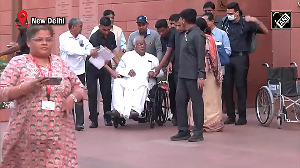Sacred chants reverberated on the banks of Kshipra as the century's first Simhasta Kumbh began early Monday with about 10 lakh people taking a dip in the river.
Sadhus arrived in huge processions and entered the waters amidst slogans of "Jai Mahakaal".
Holy men from the Juna Akhada led the 'royal bath' on the western banks of Kshipra.
For the first time, people were allowed to enter the waters before the beginning of the royal bath.
The decision was taken at a meeting of the All India Akhara Parishad and the district administration, Ujjain collector Rajesh Rajora said.
Scion of the Scindia family and Rajasthan Chief Minister Vasundhara Raje was among the first to take a dip in Kshipra just past midnight.
While the sadhus bathed at the main Ram Ghat and Dutta Akhada Ghat, others thronged the 28 newly constructed and 13 renovated ghats.
The Shaiva sect sadhus of Juna, Niranjani, Anand, Mahanirvani and Atal akhadas were the first among the holy men to enter the waters.
The Vaishnavite sect of sadhus of Nimrohi, Digamber and Nirvani akharas took bath at the Ram Ghat.
They were followed by Udaseen sect sadhus and the last to take dip were holy men from the Nirmal sect.
The royal bath got over by around 1300 IST after which the two main ghats were also opened for other people.
Following differences within Juna akhara, sadhus of Agni and Awahan were banned by the All India Akhara Parishad, the apex body governing the holy men, from taking royal bath.
They allegedly broke tradition by setting up separate camps and efforts by the district administration to bring about a compromise failed late on Sunday, Rajora said
Special forces were stationed outside the two camps to prevent them from taking royal bath, he added.
They later took dip in the river along with other people.
A small number of foreign tourists were seen enjoying the Kumbh.
"This is my second Kumbh, the previous one I attended was the 1992 Simhasta here," said Eagen, a German.
He said the large gathering impressed him.
Tight security arrangements were made in the temple city with aerial monitoring of the pilgrimage site and about 15,000 policemen, 10,000 paramilitary personnel and anti-terrorist squads keeping strict vigil.
An additional 1,000 policemen were deployed at the site to handle any emergency.






 © 2025
© 2025